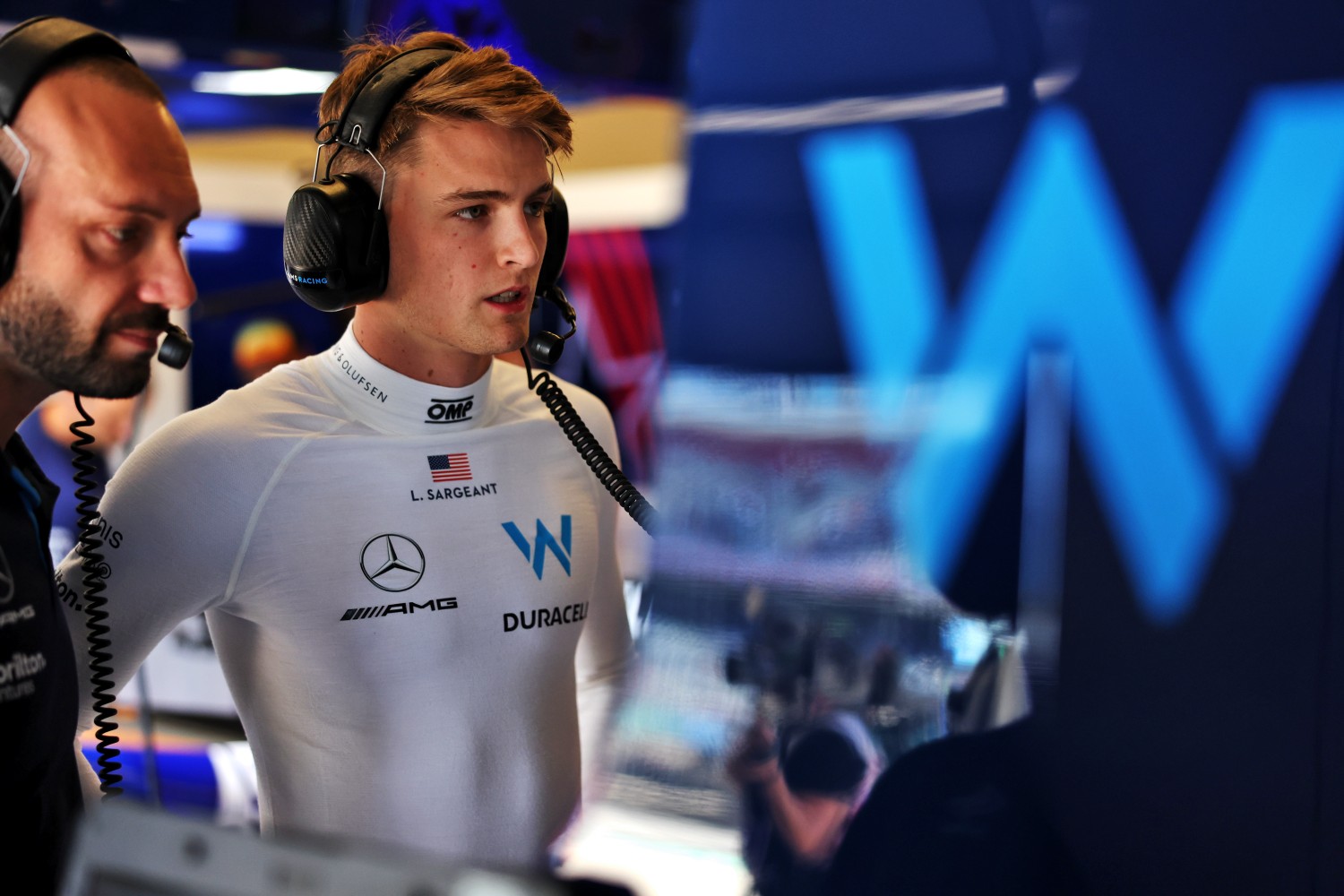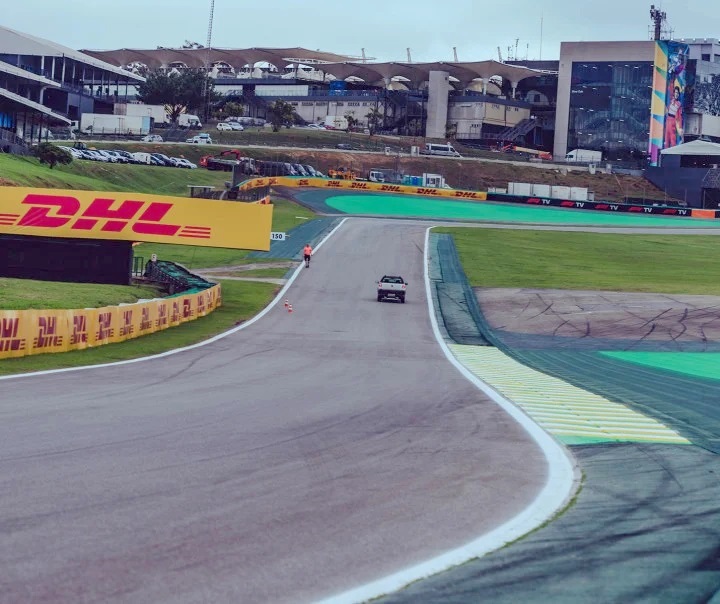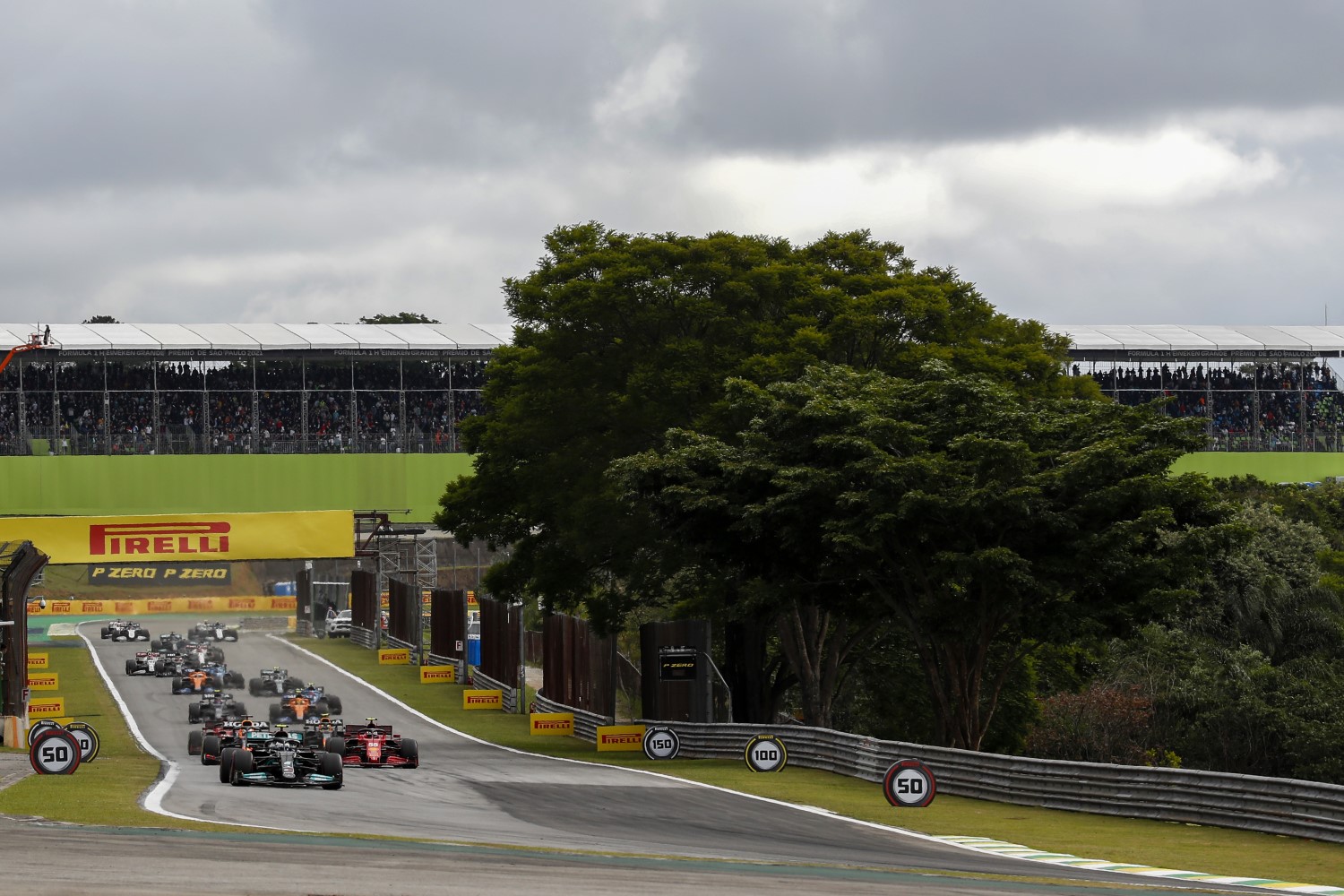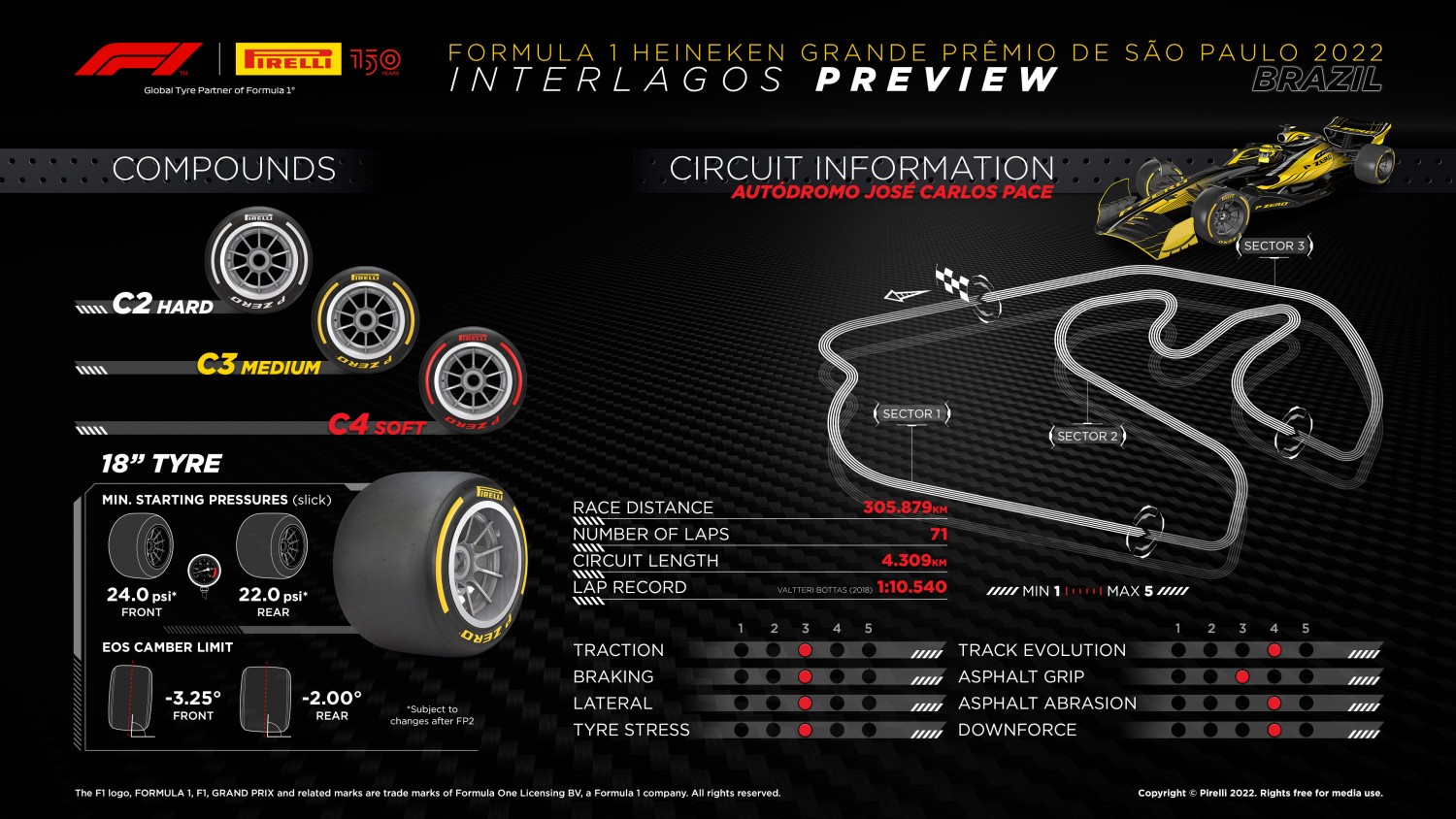F1: Brazilian GP Preview
The penultimate round of the 2022 FIA Formula 1 World Championship takes Haas F1 Team to South America, for the São Paulo Grand Prix, in Brazil.
Brazil joined Formula 1’s schedule in 1973, at Interlagos, and after a spell at Rio de Janeiro’s Jacarepaguá in the 1980s, São Paulo re-established itself as the host location in 1990. Since 2004 it has had a late-season date, with several drivers crowned World Champion, including famous denouements to the title-winning campaigns of Lewis Hamilton in 2008 and Sebastian Vettel in 2012 respectively. Last year’s comeback event, after 2020’s Covid-enforced absence, brought the revised name of the São Paulo Grand Prix after a new agreement was reached, securing Interlagos’ Formula 1 future through the 2025 season.

Interlagos takes its name from the district of São Paulo located between the man-made reservoirs of Guarapiranga and Billinges – directly translating as ‘between lakes’ – and is known as the Autódromo José Carlos Pace, as an homage to the late Brazilian Formula 1 icon, who claimed his sole win at the track in 1975. The circuit, one of Formula 1’s most compact, features two lengthy full- throttle sections joined together by a series of undulating long-radius turns.
F1 Sprint will return for its third appearance of the season, and for the second successive year at Interlagos, following its debut in 2021. That means there will be only one practice session prior to Friday’s qualifying, with the result of Saturday’s Sprint setting the grid for Sunday’s grand prix.
Logan Sargeant drives again
American Logan Sargeant continues his run of practice sessions in the Williams FW44 and this weekend will drive Alex Albon’s car during FP2. This is unusual for a Sprint Event and is more difficult than usual as Alex’s car will be in Parc Ferme during FP2 so no changes can be made to the car. However, the experience that Logan will get is invaluable, and giving him another opportunity is a good investment in his future. He did an excellent job in Austin and Mexico City, and the team is confident that he will do so again despite the unusual weekend format.
“I’m looking forward to getting back in the FW44 for FP2 in São Paulo. I can’t wait to keep progressing with the team and building on the experience I gained in Austin and Mexico City. To be given the opportunity to drive at such an iconic track like Interlagos with its banked corners and the Senna S is a great feeling. A massive thank you once again to everyone at Williams for giving me another chance to get behind the wheel.”

United States Grand Prix, Friday 21st October 2022. Circuit of the Americas, Austin, Texas, USA.
The final Sprint Race of 2022
Brazil will be the last of three F1 Sprint Race weekends for 2022. Max Verstappen won the first two Sprint races.
On a Sprint race weekend, qualifying is moved to Friday evening, followed by a 100-kilometer Sprint race on Saturday – the result of which determines the starting grid for the Grand Prix itself.
The distance of the sprint race will be equal to the lowest number of complete laps which exceed a distance of 100km.
As in the grand prix, any laps completed under the safety car will be included in the race distance.
The points for the 2022 sprint races are for places 1 to 8. The driver who finishes in first place during the sprint race gets 8 points, number 2 gets 7 points, number 3 gets 6 points and so on up to eighth place.
There is no additional fastest lap point in the Sprint, this remains only in the Grand Prix.
The finishing order of the Sprint will determine the entire grid for the Grand Prix on Sunday, meaning the Sprint winner will start Sunday’s race from the front.
It is likely that a long DRS train will form in the Sprint Race and so overtaking may be difficult. Therefore, qualifying is very important, and this will teams primary focus until FP2. The Grand Prix will depend heavily on the performance of the tires, which this weekend is from the middle of the Pirelli range. The track temperature will play a part on the tire behavior and, with the forecast currently looking tropical with rain and thunderstorms in the area on most days, it could be difficult to predict the optimum tire strategy until the race is underway. Overtaking in the Grand Prix should be easier than in the Sprint Race.
Unlocking the Lap

A lap begins immediately with the tricky ‘S’ do Senna, named after the Brazilian icon. This is a tricky downhill left-right chicane that merges into the long Curva do Sol.
Heavy braking takes place incredibly late – after the 50-metre board, with drivers decelerating and turning into the cambered, blind-apexed corner, making it easy to lock up. The second part is easy to get wrong by taking too much curb.
Turn 10 – Bico de Pato – is a tricky little hairpin at the end of a sequence of punishing long bends. This is another corner where it is easy to lock a wheel and run wide and this compromises the exit massively.

The last notable corner – Juncao, Turn 12, has been the scene where races and even a World Championship have been decided. The approach is downhill before a climb up to the corner itself. Deceptively tight, this turn needs to be mastered because of the long, uphill blast to the finish line that follows.
Fact File: São Paulo Grand Prix

- The Autódromo José Carlos Pace is the fourth-shortest track on the 2022 F1 calendar at just 4.309 km long, only behind Monaco, Zandvoort and Mexico.
- However, with 72% of the lap time at full throttle, it is the second-quickest lap time of the year behind the Red Bull Ring. The current race lap record is Valtteri’s 1m10.540 from 2018.
- The São Paulo Grand Prix venue is situated 800 meters above sea level, the second-highest altitude on the F1 calendar behind Mexico City (which is 1,500 meters higher in altitude).
- Interlagos is a track of two extremes. The first and third sectors require a low-drag car for the long straights, but the middle sector is twisty, requiring high downforce. The second DRS zone means more focus is typically on higher downforce for the ultimate fastest lap, but a balance still needs to be found with being competitive on the straights during the race.
- There is 1.2 kilometers of driving at full throttle between the exit of Turn 12 and the braking zone for Turn 1, with an elevation change of 33 meters. The images on TV really don’t do the gradient justice.
- The biggest difference in elevation is from the start/finish straight to Turn 4 where there is a 40-metre drop in elevation.
- The long straight before the lap begins also requires some clever deployment of energy from the ERS to maximize performance towards the end of the outlap, as the drivers start their flying lap.
- Turn 1 is banked heavily towards the inside, unloading the front-left wheel and causing frequent lockups. However, because the tire is unloaded, flat spots are less likely and time loss isn’t as high as you’d expect, due to the steep banking and variety of corner lines drivers can take. The variety of lines is also what makes this corner well suited to overtaking.
- The uphill grid requires the drivers to find the balance between holding the car on the brakes as gently as possible, without rolling backwards.
- From Turn 10 to Turn 6 (around 3.5 km of distance) the left-hand front tire does very little work and therefore cools down quickly, providing a tricky engineering challenge to keep the tire in its temperature window.
- With long straights and a second DRS zone, Interlagos is one of the best tracks of the season for overtaking. However, it can be difficult for the defending car to manage its battery, as there aren’t many big braking zones to recover energy.
- The São Paulo Grand Prix marks the third and final F1 Sprint of the 2022 season, following on from Imola and Austria.
- Interlagos is a very flowing circuit with a lot of combined corner entries (where you are cornering and braking at the same time), meaning good stability is important. However, you also need a good front end for the low-speed middle sector.
- Track temperatures can reach some of the hottest of the season in Brazil, up to 60°C. And thunderstorms are common around this time of year, which can potentially spice up the weekend.

Things to look out for
Overtaking: Expect plenty of moves to be made throughout the race and in the Sprint. Oval-like circuit characteristics, high tire wear and tricky braking zones into Turns One and Four all promote overtaking. In fact, over 80 percent of moves are done into T1 or T4 – the end-points of the two long DRS zones.
Safety Cars: The Safety Car often gets used at Interlagos, with 10 appearances in the last five races. The very wet 2016 race featured no fewer than six SC periods. With a low pit-lane time-loss, it is often beneficial to stop during an interruption. VSCs are much less frequent, with the two appearances both coming in 2021.
Strategy: This is regularly a two-stop race due to the ease of overtaking and tire wear, with Pirelli bringing the C2, C3 and C4 compounds for the last time in 2022. The weather can change in an instant and can cause mayhem during a race weekend, keeping every strategist and mechanic on their toes.
Pirelli Tires
MARIO ISOLA – MOTORSPORT DIRECTOR
“The three compounds in the middle of the range for a circuit where we expect a lot of overtaking”
“Formula 1 heads to Interlagos next weekend: the shortest lap of the year after Monaco and Mexico. It’s a historic track run anti-clockwise, which alternates some quick sections as well as medium-speed sequences of corners, such as the famous ‘Senna esses’. There aren’t any big demands on the tires in terms of traction and braking because it’s a very flowing layout, and the lack of slow corners means that the teams are able to control the degradation on the rear tires. Brazil will host the “Sprint” also this year, the last of the season, and it will be particularly interesting with this car package to see what will happen on the track and, once again, the key role of the different strategies that can be used: in 2021 the grid on Saturday was equally split between drivers starting on the medium and the soft tires. Despite the short length of the track, there’s normally plenty of overtaking. Just think of Lewis Hamilton who was the protagonist of a comeback that brought him to victory from 10th place, using a two-stop strategy. So the new generation of cars and tires seems set to provide us with another thrilling race this year.”

THE TIRES ON TRACK
- Pirelli will bring the three compounds in the middle of the range to the Brazilian Grand Prix: C2 will be the P Zero White hard, C3 will be the P Zero Yellow medium, and C4 will be the P Zero Red soft. The previous two races in Austin and Mexico City used the same selection.
- Interlagos will host the third and final F1 Sprint race of the season, after Imola and Spielberg. As a result, the Pirelli Pole Position Award will be given out on Friday after qualifying.
- The Autodromo José Carlos Pace, named after the famous Brazilian driver of Italian origin, runs anti-clockwise and contains 15 corners, which place medium lateral demands on the tires.
- The Brazilian Grand Prix is well-known for plenty of overtaking and frequent appearances from the safety car. The weather is always another question mark, with torrential rain as well as high temperatures and sunshine seen in previous years.
- The teams used varying strategies in 2021 but the drivers on the podium all stopped twice. Lewis Hamilton, the winner, finished the race on P Zero White hard ahead of Max Verstappen and Valtteri Bottas on the same compound.
